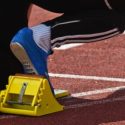Ahh….spring is in the air. And with it comes the blooming flowers, more sunshine to enjoy in the afternoons, the breakout of capris and tees from storage, and of course, spring training for upcoming races!!
To add a little spice to my workouts, I signed up for a Duathlon (that would be a run, bike, run combo–no tri doggy paddling for this girl). Now in the past, when I’ve signed up for any kind of race, I immediately drew out a training schedule for my workouts.
What I ate was usually a secondary thought (Ok, sometimes it was a tertiary thought…)
Oh, how times have changed. My focus now is what to eat before and after my training sessions, as well as having an organized exercise plan. Having a well-balanced eating plan coinciding with your exercise routine can enhance your performance by providing your muscles with fuel and repairing your tissues so you can get stronger and be ready for your next workout. Keeping a food and activity journal helps you stick to your goals by tracking your calorie intake and output, discovering those pesky eating triggers, wiping out bad habits, and learning how to motivate your body by eating properly and staying active.
Now, I don’t plan on bringing home a trophy (although my husband says he’ll clear off a space on the mantle for one). My race goal is pretty simple: Finishing strong thanks to my balanced nutrition and training plan.
Did I mention finishing??!
Here are fundamental nutrition tips for those of you that are the mere mortal, non-elite athletes training to finish strong in a race:
PRE-WORKOUT GRUB
Filling up your body’s energy tank prior to a workout can provide you with more energy during your workout. The challenge is knowing how much food you can consume before your workout. Everyone is unique and will burn fuel at a different rate: Some can eat a full meal as little as an hour before a workout, while others have to wait much longer. Ensure that what you eat is easily digestible. You should experiment with the timing to suit your individual needs and keep track of it in your food/activity log.
If you’re an early riser, you want to make sure that you have consumed something that will get you through your training. Remember that your body has been without food for several hours during the night, so you cannot expect to get the best out of your training if you do not fuel your body properly. Eat foods that sit well in your stomach in the morning. This could be a yogurt smoothie, banana, oatmeal with whey protein mixed in, or a slice of whole wheat toast with peanut butter.
SKIPPING MEALS IS A NO-NO
You might think training for a race is a great time to cut back on calories so you can lose some weight before the big race. WRONG! When you increase the intensity and the duration of your workouts, you need to nourish your body adequately. This means putting an eating plan in place that will ensure you are meeting your body’s increased nutrient needs. Skipping a meal will unfortunately set you up for an overindulging disaster later on in the day.
BECOMING A VACUUM AFTER WORKOUTS
You just completed an amazing workout and you feel alive and energetic, albeit a little tired as well. You go to eat something and think, “Hmm, I must have burned at least 2000 calories during my workout! I’ve earned that second helping AND that triple thick, extra large chocolate shake.” Don’t devour everything that falls helplessly in your path after a long training session. You can still eat your favorite foods as long as portions are kept in check and a balanced menu is in place.
EAT UP RIGHT AFTER YOUR WORKOUTS
After an intense workout, your body is ready to soak up nutrients used to refill and repair your body. Protein assists with muscle repair and growth while muscles rely on carbs for fuel. Make sure you are eating the right combination of high-quality protein and complex carbohydrates within 30 minutes to one hour after your workouts in order to speed post-workout recovery. Studies show that the balance is a 4 to 1 ratio of carbs to protein.
When you train in the evening, you might not be ready to eat dinner until very late. Later that big meal will still be churning away when you go nighty-night which can influence your sleep and increase your storage of fat. Eat your main meal at lunch and consume a small post-training meal. A few ideas are eggs on toast, homemade bean and veggie soup with bread, or a small protein & carb shake. Find what works best for you!
QUENCH THAT THIRST
Hydration is a key element of training for any endurance event. Proper hydration enhances performance, helps cool the body, delays fatigue, and prevents injuries associated with dehydration and sweat loss. Make sure you are satisfying your basic fluid requirements as well as increased fluid needs when training. Hydrate before, during, and after exercise.
SUM UP
What you eat plays a huge role in your training. Without putting an eating plan into place you will undermine all the hard work you’ve been establishing. You want to make sure that you are nourishing yourself correctly by eating a wide variety from each food group to ensure you get the nutrients your body needs to recover and grow stronger after each training session. Tracking your food (don’t forget water too!) and activity will keep your training and nutrition goals in check. Having a solid nutrition plan will get you to that finish line.
Finish strong….and maybe bring home that trophy!
© 2024 OLD TOWN ATHLETIC CLUB | SITE BY: PROFECTA MARKETING | Funding Provided in Part by Fauquier County Development Economic Authority
